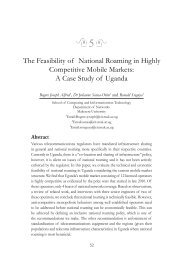Undergraduate Handbook - School of Computing and Informatics ...
Undergraduate Handbook - School of Computing and Informatics ...
Undergraduate Handbook - School of Computing and Informatics ...
You also want an ePaper? Increase the reach of your titles
YUMPU automatically turns print PDFs into web optimized ePapers that Google loves.
iii. A. Burns <strong>and</strong> A. Wellings, Real-Time Systems <strong>and</strong> Programming Languages, Addison Wesley, 3rd edition,<br />
2001.<br />
BSE 3103: Requirements Engineering (4 CU)<br />
Course Description: At the end <strong>of</strong> the course students should be able to: Underst<strong>and</strong> the principles, tools, <strong>and</strong><br />
techniques for requirements elicitation, specification, <strong>and</strong> analysis; demonstrate the role <strong>of</strong> requirements in system<br />
development <strong>and</strong> maintenance; <strong>and</strong> appreciate the difficulties <strong>of</strong> specifying requirements for real systems, as well as<br />
effective methods tools <strong>and</strong> techniques.<br />
Indicative Content: System <strong>and</strong> S<strong>of</strong>tware System Engineering; S<strong>of</strong>tware Requirements Concepts; Requirements<br />
Elicitation; S<strong>of</strong>tware Requirements Analysis, S<strong>of</strong>tware Requirements Specifications, S<strong>of</strong>tware Requirements Tools,<br />
S<strong>of</strong>tware Requirements Verification; S<strong>of</strong>tware Requirements Engineering Management; Developing a Successful<br />
S<strong>of</strong>tware Requirement.<br />
Reference Books:<br />
i. P. Loucopoulos <strong>and</strong> V. Karakostas, System Requirements Engineering, McGraw-Hill.<br />
ii. D. Leffingwell, D. Widrig, A. Wesley, Managing S<strong>of</strong>tware Requirements: A Use Case Approach, 2nd<br />
edition, Boston.<br />
iii. L. Chung, B. Nixon, E. Yu <strong>and</strong> J. Mylopoulos, Non-Functional Requirements in S<strong>of</strong>tware Engineering,<br />
Kluwer Academic Publishing, 2000.<br />
iv. A. M. Davis, S<strong>of</strong>tware Requirements: Objects, Functions, & States, Prentice Hall: Englewood Cliffs, 1993.<br />
v. R. H. Thayer <strong>and</strong> M. Dortman, System <strong>and</strong> S<strong>of</strong>tware Requirements Engineering: Tutorial, (Editors), IEEE<br />
Computer Society Press.<br />
BSE 3105: S<strong>of</strong>tware Evolution (4 CU)<br />
Course Description: In this course, students will learn: How selected s<strong>of</strong>tware systems can be analyzed to<br />
underst<strong>and</strong> properties <strong>of</strong> their evolution; <strong>and</strong> interpret their implication.<br />
Indicative Content: Separate compilation; design issues; verification <strong>and</strong> validation; integrating components;<br />
documentation , Issues in object-oriented programming; parallelism; event centered programming; common design<br />
patterns; s<strong>of</strong>tware reuse, The Laws <strong>of</strong> S<strong>of</strong>tware Evolution Client-server computing: S<strong>of</strong>tware support needed for<br />
client <strong>and</strong> server implementation; varieties <strong>of</strong> server structures; Reverse engineering <strong>and</strong> reverse engineering tools,<br />
recognizing s<strong>of</strong>tware architecture <strong>and</strong> design patterns in existing s<strong>of</strong>tware systems S<strong>of</strong>tware transformation,<br />
migration, <strong>and</strong> reengineering, recovering s<strong>of</strong>tware components for reuse<br />
Reference Books:<br />
i. L. J. Arthur, S<strong>of</strong>tware Evolution: A S<strong>of</strong>tware Maintenance Challenge, John Wiley & Sons, 1988.<br />
ii. R. C. Seacord, D. Plakosh, <strong>and</strong> G. A. Lewis, Modernizing Legacy Systems: S<strong>of</strong>tware Technologies,<br />
Engineering Processes, <strong>and</strong> Business Practices, Addison-Wesley Pub Co; 1st edition, 2003.<br />
iii. T. M. Pigoski, Practical S<strong>of</strong>tware Maintenance: Best Practices for Managing Your S<strong>of</strong>tware Investment,<br />
John Wiley & Sons, 1st edition, 1996.<br />
iv. D. D. Smith, Designing Maintainable S<strong>of</strong>tware, Springer-Verlag, 1999.<br />
v. R. B. Grady, S<strong>of</strong>tware Metrics: Establishing A Company-Wide Program, Prentice Hall; 1st edition, 1987.<br />
BSE 3106: Mobile Networks <strong>and</strong> <strong>Computing</strong> (4 CU)<br />
Course Description: At the end <strong>of</strong> the course, students will be able to: Underst<strong>and</strong> the basic principle, architecture<br />
<strong>and</strong> challenges <strong>of</strong> wireless networks <strong>and</strong> mobile computing systems; <strong>and</strong> demonstrate knowledge <strong>of</strong> s<strong>of</strong>tware<br />
development related to mobile computing systems.<br />
117

















